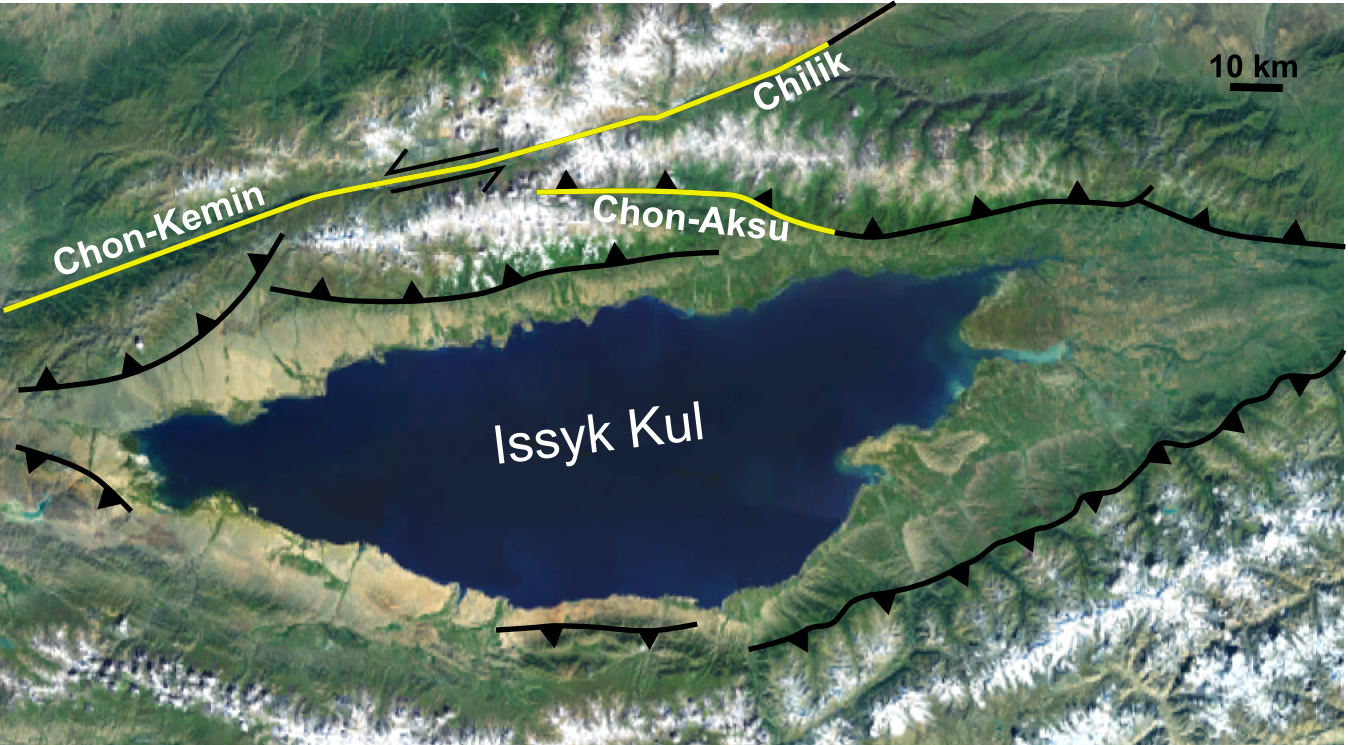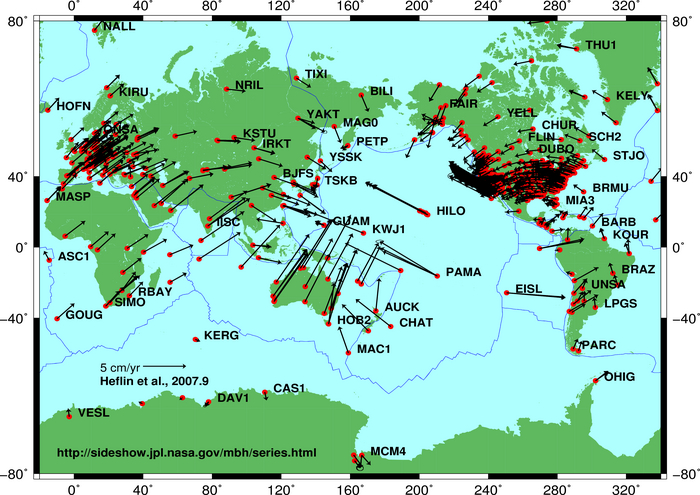|
1911 Kebin Earthquake
The 1911 Kebin earthquake, or Chon-Kemin earthquake, struck Russian Turkestan on 3 January. Registering at a moment magnitude of 8.0, it killed 452 people, destroyed more than 770 buildings (which was almost all of the city) in Almaty, Kazakhstan, and resulted in of surface faulting in the valleys of Chon-Kemin, Chilik and Chon-Aksu. Damage Most of the region's inhabitants lived in yurts, which are relatively resistant to earthquakes and unlikely to cause deaths even if they do collapse. The greatest damage and most of the casualties resulted from landslides triggered by the earthquake, with 452 people killed and another 740 people injured. Nearly 1,100 houses and 4,545 yurts were destroyed by the earthquake and the resulting landslides. Tectonic setting The Tien Shan mountains form part of the broad zone of deformation associated with the continuing collision between the Indian Plate and the Eurasian Plate. In the region around Issyk Kul, the tectonic regime is a combinati ... [...More Info...] [...Related Items...] OR: [Wikipedia] [Google] [Baidu] |
Kyrgyzstan
Kyrgyzstan,, pronounced or the Kyrgyz Republic, is a landlocked country in Central Asia. Kyrgyzstan is bordered by Kazakhstan to the north, Uzbekistan to the west, Tajikistan to the south, and the People's Republic of China to the east. Its capital and largest city is Bishkek. Ethnic Kyrgyz make up the majority of the country's seven million people, followed by significant minorities of Uzbeks and Russians. The Kyrgyz language is closely related to other Turkic languages. Kyrgyzstan's history spans a variety of cultures and empires. Although geographically isolated by its highly mountainous terrain, Kyrgyzstan has been at the crossroads of several great civilizations as part of the Silk Road along with other commercial routes. Inhabited by a succession of tribes and clans, Kyrgyzstan has periodically fallen under larger domination. Turkic nomads, who trace their ancestry to many Turkic states. It was first established as the Yenisei Kyrgyz Khaganate later in the ... [...More Info...] [...Related Items...] OR: [Wikipedia] [Google] [Baidu] |
Ramp Basin
A ramp basin is a geological depression bounded by a pair of opposite facing reverse faults or thrust faults. In rifting, the equivalent structure is a graben, although the bounding faults are normal rather than reverse in type. Examples of this type of basin include the Cul-de-Sac depression in Haiti and Issyk-Kul in the Tian Shan mountains in Kyrgyzstan Kyrgyzstan,, pronounced or the Kyrgyz Republic, is a landlocked country in Central Asia. Kyrgyzstan is bordered by Kazakhstan to the north, Uzbekistan to the west, Tajikistan to the south, and the People's Republic of China to the ea .... References {{Reflist Structural basins ... [...More Info...] [...Related Items...] OR: [Wikipedia] [Google] [Baidu] |
1911 Earthquakes
A notable ongoing event was the Comparison of the Amundsen and Scott Expeditions, race for the South Pole. Events January * January 1 – A decade after federation, the Northern Territory and the Australian Capital Territory are added to the Commonwealth of Australia. * January 3 ** 1911 Kebin earthquake: An earthquake of 7.7 Moment magnitude scale, moment magnitude strikes near Almaty in Russian Turkestan, killing 450 or more people. ** Siege of Sidney Street in London: Two Latvian people, Latvian anarchists die, after a seven-hour siege against a combined police and military force. Home Secretary Winston Churchill arrives to oversee events. * January 5 – Egypt's Zamalek SC is founded as a general sports and Association football club by Belgian lawyer George Merzbach as Qasr El Nile Club. * January 14 – Roald Amundsen's South Pole expedition makes landfall, on the eastern edge of the Ross Ice Shelf. * January 18 – Eugene B. El ... [...More Info...] [...Related Items...] OR: [Wikipedia] [Google] [Baidu] |
1911 In The Russian Empire
A notable ongoing event was the Comparison of the Amundsen and Scott Expeditions, race for the South Pole. Events January * January 1 – A decade after federation, the Northern Territory and the Australian Capital Territory are added to the Commonwealth of Australia. * January 3 ** 1911 Kebin earthquake: An earthquake of 7.7 Moment magnitude scale, moment magnitude strikes near Almaty in Russian Turkestan, killing 450 or more people. ** Siege of Sidney Street in London: Two Latvian people, Latvian anarchists die, after a seven-hour siege against a combined police and military force. Home Secretary Winston Churchill arrives to oversee events. * January 5 – Egypt's Zamalek SC is founded as a general sports and Association football club by Belgian lawyer George Merzbach as Qasr El Nile Club. * January 14 – Roald Amundsen's South Pole expedition makes landfall, on the eastern edge of the Ross Ice Shelf. * January 18 – Eugene B. El ... [...More Info...] [...Related Items...] OR: [Wikipedia] [Google] [Baidu] |
Earthquakes In Kyrgyzstan
An earthquake (also known as a quake, tremor or temblor) is the shaking of the surface of the Earth resulting from a sudden release of energy in the Earth's lithosphere that creates seismic waves. Earthquakes can range in intensity, from those that are so weak that they cannot be felt, to those violent enough to propel objects and people into the air, damage critical infrastructure, and wreak destruction across entire cities. The seismic activity of an area is the frequency, type, and size of earthquakes experienced over a particular time period. The seismicity at a particular location in the Earth is the average rate of seismic energy release per unit volume. The word ''tremor'' is also used for non-earthquake seismic rumbling. At the Earth's surface, earthquakes manifest themselves by shaking and displacing or disrupting the ground. When the epicenter of a large earthquake is located offshore, the seabed may be displaced sufficiently to cause a tsunami. Earthquakes c ... [...More Info...] [...Related Items...] OR: [Wikipedia] [Google] [Baidu] |
Earthquakes In Kazakhstan
An earthquake (also known as a quake, tremor or temblor) is the shaking of the surface of the Earth resulting from a sudden release of energy in the Earth's lithosphere that creates seismic waves. Earthquakes can range in intensity, from those that are so weak that they cannot be felt, to those violent enough to propel objects and people into the air, damage critical infrastructure, and wreak destruction across entire cities. The seismic activity of an area is the frequency, type, and size of earthquakes experienced over a particular time period. The seismicity at a particular location in the Earth is the average rate of seismic energy release per unit volume. The word ''tremor'' is also used for non-earthquake seismic rumbling. At the Earth's surface, earthquakes manifest themselves by shaking and displacing or disrupting the ground. When the epicenter of a large earthquake is located offshore, the seabed may be displaced sufficiently to cause a tsunami. Earthquakes ca ... [...More Info...] [...Related Items...] OR: [Wikipedia] [Google] [Baidu] |
Earthquakes In Russia
An earthquake (also known as a quake, tremor or temblor) is the shaking of the surface of the Earth resulting from a sudden release of energy in the Earth's lithosphere that creates seismic waves. Earthquakes can range in intensity, from those that are so weak that they cannot be felt, to those violent enough to propel objects and people into the air, damage critical infrastructure, and wreak destruction across entire cities. The seismic activity of an area is the frequency, type, and size of earthquakes experienced over a particular time period. The seismicity at a particular location in the Earth is the average rate of seismic energy release per unit volume. The word ''tremor'' is also used for non-earthquake seismic rumbling. At the Earth's surface, earthquakes manifest themselves by shaking and displacing or disrupting the ground. When the epicenter of a large earthquake is located offshore, the seabed may be displaced sufficiently to cause a tsunami. Earthquakes c ... [...More Info...] [...Related Items...] OR: [Wikipedia] [Google] [Baidu] |
1902 Turkestan Earthquake
The 1902 Turkestan earthquake (also known as the Artux/Artush and Kashgar earthquake) devastated Xinjiang, China, near the Kyrgyzstan border. It occurred on August 22, 1902, at about 8:00 or 9:00 am local time with an epicenter near the Tien Shan mountains. The thrust earthquake measured 7.7 on the moment magnitude scale () and initiated at a depth of . The Tien Shan mountains is situated in a zone of complex convergence caused by the Indian–Eurasian plate interaction. This zone is actively deforming—accommodated by active thrust faults responsible for seismic activity. The mainshock was preceded by an intense series of foreshocks in the years prior. Many aftershocks followed, several were larger than magnitude 6.0 and one measured magnitude 6.8–7.3. These aftershocks were recorded for three years. Additional shocks were recorded over a decade after the mainshock. An estimated 5,650–10,000 people were killed in the mainshock. Widespread destruction occurred—at least 30,0 ... [...More Info...] [...Related Items...] OR: [Wikipedia] [Google] [Baidu] |
List Of Earthquakes In Kyrgyzstan
The following is a list documenting major earthquakes that have occurred in Kyrgyzstan. The list also include earthquakes with epicenters outside the country, but caused significant impact in Kyrgyzstan. List References Source * {{Earthquakes in Kyrgyzstan Kyrgyzstan Kyrgyzstan,, pronounced or the Kyrgyz Republic, is a landlocked country in Central Asia. Kyrgyzstan is bordered by Kazakhstan to the north, Uzbekistan to the west, Tajikistan to the south, and the People's Republic of China to the ea ... Earthquakes in Kyrgyzstan Natural disasters in Kyrgyzstan Geology of Kyrgyzstan Earthquakes ... [...More Info...] [...Related Items...] OR: [Wikipedia] [Google] [Baidu] |
List Of Earthquakes In 1911
A ''list'' is any set of items in a row. List or lists may also refer to: People * List (surname) Organizations * List College, an undergraduate division of the Jewish Theological Seminary of America * SC Germania List, German rugby union club Other uses * Angle of list, the leaning to either port or starboard of a ship * List (information), an ordered collection of pieces of information ** List (abstract data type), a method to organize data in computer science * List on Sylt, previously called List, the northernmost village in Germany, on the island of Sylt * ''List'', an alternative term for ''roll'' in flight dynamics * To ''list'' a building, etc., in the UK it means to designate it a listed building that may not be altered without permission * Lists (jousting), the barriers used to designate the tournament area where medieval knights jousted * ''The Book of Lists'', an American series of books with unusual lists See also * The List (other) * Listing (di ... [...More Info...] [...Related Items...] OR: [Wikipedia] [Google] [Baidu] |
Granite
Granite () is a coarse-grained (phaneritic) intrusive igneous rock composed mostly of quartz, alkali feldspar, and plagioclase. It forms from magma with a high content of silica and alkali metal oxides that slowly cools and solidifies underground. It is common in the continental crust of Earth, where it is found in igneous intrusions. These range in size from dikes only a few centimeters across to batholiths exposed over hundreds of square kilometers. Granite is typical of a larger family of ''granitic rocks'', or ''granitoids'', that are composed mostly of coarse-grained quartz and feldspars in varying proportions. These rocks are classified by the relative percentages of quartz, alkali feldspar, and plagioclase (the QAPF classification), with true granite representing granitic rocks rich in quartz and alkali feldspar. Most granitic rocks also contain mica or amphibole minerals, though a few (known as leucogranites) contain almost no dark minerals. Granite is nearly alway ... [...More Info...] [...Related Items...] OR: [Wikipedia] [Google] [Baidu] |
Limestone
Limestone ( calcium carbonate ) is a type of carbonate sedimentary rock which is the main source of the material lime. It is composed mostly of the minerals calcite and aragonite, which are different crystal forms of . Limestone forms when these minerals precipitate out of water containing dissolved calcium. This can take place through both biological and nonbiological processes, though biological processes, such as the accumulation of corals and shells in the sea, have likely been more important for the last 540 million years. Limestone often contains fossils which provide scientists with information on ancient environments and on the evolution of life. About 20% to 25% of sedimentary rock is carbonate rock, and most of this is limestone. The remaining carbonate rock is mostly dolomite, a closely related rock, which contains a high percentage of the mineral dolomite, . ''Magnesian limestone'' is an obsolete and poorly-defined term used variously for dolomite, for limes ... [...More Info...] [...Related Items...] OR: [Wikipedia] [Google] [Baidu] |







